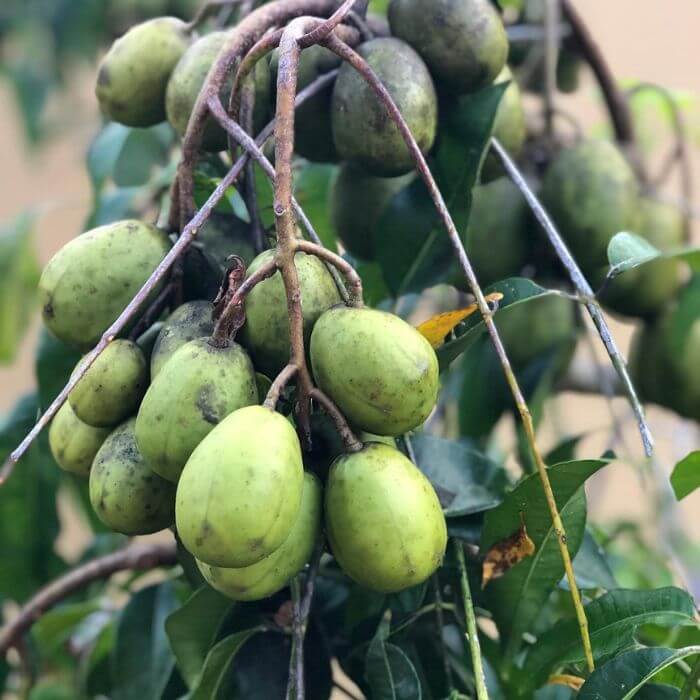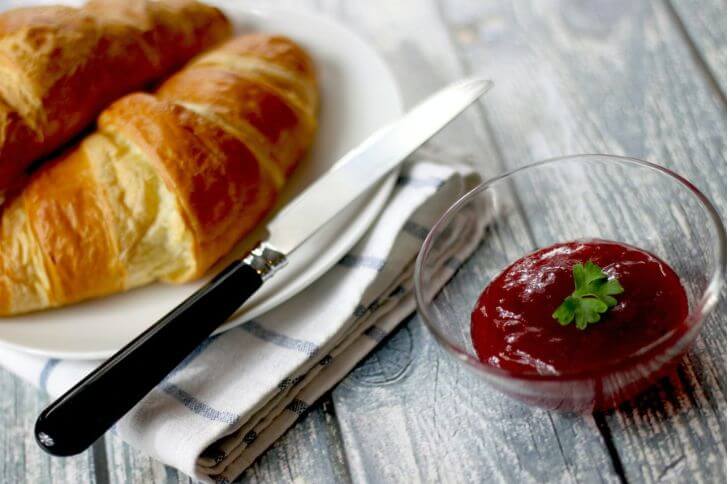Caja fruit, also known as spondias mombin, is a small-sized fruit that is easily recognizable by its bright yellow skin. Note the smooth texture.
The caja fruit is also known by several other names including yellow mombin, jobo and hog plum. In this article we’ll referer it by its two most common names; caja or yellow mombin.
What is caja fruit?
Yellow mombins are small, round and yellow in color with a thin skin and fibrous flesh. They have a sweet-sour flavor that make them perfect for eating as a snack or using in recipes.
In terms of classification, the yellow mombin belongs to the Anacardiaceae family, which also includes mangoes and cashews.
It is classified as spondias mombin in scientific nomenclature. The fruit is native to Central America and South America but can now be found in many tropical regions around the world.
Caja color
The yellow mombin color can vary from light green to bright yellow, depending on the stage.
When the caja fruit is unripe, its skin is greenish and when pressed it feels hard. When fully ripe, this oval-round fruit has an unmistakable yellow hue.
Testing for ripeness

source; prismwalls
Appearance: Caja fruit is typically green and hard when unripe, but it turns yellow and soft once it is ripe. Look for a uniform yellow color with no visible green areas on the skin.
Texture: The fruit should be slightly soft to the touch when ripe. Press gently on the skin with your finger – if it gives a little, it’s ready to eat.
Smell: A ripe yellow mombin will have a sweet, tropical aroma that is noticeable even from a distance. If you can’t smell anything, the fruit may not be fully ripe.
Weight: As it ripens, it becomes heavier due to increased moisture content inside the flesh. Pick up the fruit and feel its weight – if it feels light or hollow inside, it’s likely not yet fully mature.
Taste: Ultimately, the best way to tell if a caja fruit is ripe is by tasting it! Cut into the flesh carefully with a knife and take a small bite – if it’s sweet-sour and juicy, congratulations! You’ve found yourself a perfectly ripe caja fruit!
Preparation:
If you have never prepared caja fruit before, it may seem intimidating at first. Here are some steps to follow:
- Choose ripe caja fruit – it should be yellow in color and give slightly when pressed.
- Cut off the top of the fruit (where the stem was) with a sharp knife.
- Slice off each end of the fruit so that it stands upright on its own.
- Make vertical cuts down the sides of the caja, being careful not to cut all the way through.
- Use your fingers to gently pry open each segment of flesh and remove any seeds inside.
- Once all segments have been opened up and cleaned out, they can be eaten as is or used in recipes.
Where does yellow mombin come from?
Yellow mombin trees can grow up to 66 ft tall and require warm temperatures, high humidity levels, and well-drained soil to thrive. These fruits are mostly cultivated in Brazil, Jamaica, Mexico, Nigeria and Cuba.
Cultivating yellow mombin typically involves planting seeds or seedlings in well-prepared soil during the wet season. The trees take about three years to mature before they start bearing fruits. Proper care should be taken throughout this period by providing adequate water, fertilizers, and pest control measures.
Harvesting of yellow mombin usually starts when the fruits begin to change from green to yellow. They are hand-picked from the tree using a long pole with a hook at the end or by climbing ladders.
Nutrition facts:
One cup of caja fruit has 53 cal, 12g carbs, 0.1g fat. Other benefits include vitamin A, B, and C.
When is caja fruit in season
In South America, hog plum trees flower in January through May and fruits are present from July to September.
During this time, you can find fresh caja fruits at local markets and grocery stores. However, depending on where you live, it may be difficult to find fresh caja fruits outside of South America.
Fortunately, there are other ways to enjoy this tasty fruit even if it’s not currently in season. You can often find canned or frozen caja fruits at specialty markets or online retailers.
These options are great for enjoying the flavor of caja year-round and make a delicious addition to smoothies, cocktails or sorbets.
Related Read: learn about rambutans
Eating hog plums

This yellow fruit has a sweet and sour taste. If you’re wondering how to eat yellow mombin, here are some ways:
1. Fresh: The simplest way to enjoy yellow mombin is by eating it fresh off the tree. Simply peel off the skin and remove the seed in the center.
2. Jam or jelly: You can use this yellow fruit to make jam or jelly by boiling it down with sugar until it thickens.
3. Salsa: Another way to enjoy this fruit is by making salsa with diced caja, tomatoes, onions, cilantro, lime juice, salt and pepper.
4. Ice cream or sorbet: Cajas can be used as an ingredient in ice cream or sorbet for a unique tropical flavor.
Overall, there are many ways to eat and enjoy hog plums- whether you prefer it fresh off the tree or incorporated into tasty recipes like jam or salsa – this versatile tropical fruit is worth trying if you get your hands on it!
Ways to drink
Here are some of the most popular ways to drink yellow mombin:
1. Yellow mombin juice: To make this refreshing drink, simply blend fresh fruit or powder with water and sugar until smooth. Optionally, you can add mint leaves for extra flavor.
2. Smoothie: For a thicker and creamier option, blend jobos with yogurt or milk and ice cubes until smooth. You can also add other fruits like banana or mango to create your own unique recipe.
Have a lot of caja fruits, here is how to blend into powder for future use:
Ingredients:
-Hog plums
Instructions:
– Collect/buy fresh hog plums.
– Wash and dry them thoroughly.
– Remove seed, then chop
– Use a dehydrator to dry.
– Grind the dried pieces into a fine powder using a grinder or mortar and pestle.
– Store in airtight container
– Use as desired to add a tangy, sour flavor to dishes or beverages.
What does hog plum taste like?
It has a unique taste that is both tangy and sweet, with hints of sourness. The texture of the fruit is soft and juicy, with a fibrous center.
How to store mombin fruit
One of the first things you should do after purchasing yellow mombin is to sort them out and remove any fruits that have bruises or damage.
After sorting out your yellow mombins, store them in a cool, dry place such as the refrigerator. If you plan on consuming the fruits within two days of purchase, leave them at room temperature until they ripen fully before refrigerating.
If you don’t plan on eating them soon after purchase, it’s advisable to freeze or can them for future use.
Another important aspect when storing yellow mombins is proper packaging. They tend to dehydrate quickly if left uncovered; therefore, pack them in an airtight container or plastic bag with some space for air circulation and moisture absorption.
With these storage tips in mind, you can enjoy healthy and delicious cajas all year round without worrying about spoilage or deterioration.
Where to get
These yellow fruits are popular in South America, particularly Brazil. They are also common in parts of Africa.
One way to get caja fruits is to visit a local farmer’s market. These stores may have fresh hog plums available when they are in season, which typically runs from July through September.
Another option for obtaining these plums is to look for them online. Many online retailers offer exotic fruits like hog plums for purchase and will ship them directly to your home.
It’s important to note that shipping times may vary depending on where you live and the availability of the fruit.
Hog plum vs june plum
Hog plum and June plum are two popular fruits that often get confused with each other. Both fruits have a similar size and shape, but they differ in their taste, texture, and color.
Hog plum has a bright yellow color when ripe and has a tangy flavor with hints of sweetness. The flesh of hog plum is juicy, making it an ideal ingredient for salads or smoothies.
On the other hand, june plum is also known as golden apple or ambarella. It also has a yellow skin when ripe and has a sweet-spicy flavor that resembles mangoes or pineapples. The flesh of june plum is soft, making it perfect for jams or chutneys.
Also hog plum are smaller than june plums. Each fruit has one seed with the june plum’s seed having fibers sticking out of it.
Do hog plums have worms
According to experts, hog plums do not naturally have worms inside them. The presence of worms may occur due to external factors such as insects laying their eggs on the fruit or improper storage conditions.
To avoid consuming worm-infested cajas, it is essential to inspect the fruit carefully before consuming it.
To check for worms, one can cut them open and examine the flesh for any signs of infestation. If any holes or tunnels are present, this may indicate that insects have laid their eggs inside the fruit. It is recommended to discard these fruits immediately and choose fresh ones instead.
source:
Hi There,
My name is Jenny. I’m the Chief Editor at Try Green Recipes and besides making yummy and healthy foods for my kids, grandkids, and friends. I’m new to the blogging world but I believe what I have to share is unique and will bring joy to your home. If you are adventurous and want try something tasty, let’s get started.

